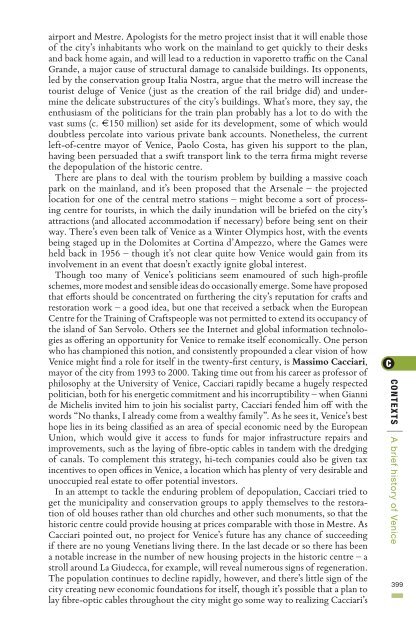You also want an ePaper? Increase the reach of your titles
YUMPU automatically turns print PDFs into web optimized ePapers that Google loves.
airport <strong>and</strong> Mestre. Apologists for <strong>the</strong> metro project insist that it will enable those<br />
of <strong>the</strong> city’s inhabitants who work on <strong>the</strong> mainl<strong>and</strong> <strong>to</strong> get quickly <strong>to</strong> <strong>the</strong>ir desks<br />
<strong>and</strong> back home again, <strong>and</strong> will lead <strong>to</strong> a reduction in vaporet<strong>to</strong> traffic on <strong>the</strong> Canal<br />
Gr<strong>and</strong>e, a major cause of structural damage <strong>to</strong> canalside buildings. Its opponents,<br />
led by <strong>the</strong> conservation group Italia Nostra, argue that <strong>the</strong> metro will increase <strong>the</strong><br />
<strong>to</strong>urist deluge of <strong>Venice</strong> ( just as <strong>the</strong> creation of <strong>the</strong> rail bridge did) <strong>and</strong> undermine<br />
<strong>the</strong> delicate substructures of <strong>the</strong> city’s buildings. What’s more, <strong>the</strong>y say, <strong>the</strong><br />
enthusiasm of <strong>the</strong> politicians for <strong>the</strong> train plan probably has a lot <strong>to</strong> do with <strong>the</strong><br />
vast sums (c. e150 million) set aside for its development, some of which would<br />
doubtless percolate in<strong>to</strong> various private bank accounts. None<strong>the</strong>less, <strong>the</strong> current<br />
left-of-centre mayor of <strong>Venice</strong>, Paolo Costa, has given his support <strong>to</strong> <strong>the</strong> plan,<br />
having been persuaded that a swift transport link <strong>to</strong> <strong>the</strong> terra firma might reverse<br />
<strong>the</strong> depopulation of <strong>the</strong> his<strong>to</strong>ric centre.<br />
<strong>The</strong>re are plans <strong>to</strong> deal with <strong>the</strong> <strong>to</strong>urism problem by building a massive coach<br />
park on <strong>the</strong> mainl<strong>and</strong>, <strong>and</strong> it’s been proposed that <strong>the</strong> Arsenale – <strong>the</strong> projected<br />
location for one of <strong>the</strong> central metro stations – might become a sort of processing<br />
centre for <strong>to</strong>urists, in which <strong>the</strong> daily inundation will be briefed on <strong>the</strong> city’s<br />
attractions (<strong>and</strong> allocated accommodation if necessary) before being sent on <strong>the</strong>ir<br />
way. <strong>The</strong>re’s even been talk of <strong>Venice</strong> as a Winter Olympics host, with <strong>the</strong> events<br />
being staged up in <strong>the</strong> Dolomites at Cortina d’Ampezzo, where <strong>the</strong> Games were<br />
held back in 1956 – though it’s not clear quite how <strong>Venice</strong> would gain from its<br />
involvement in an event that doesn’t exactly ignite global interest.<br />
Though <strong>to</strong>o many of <strong>Venice</strong>’s politicians seem enamoured of such high-profile<br />
schemes, more modest <strong>and</strong> sensible ideas do occasionally emerge. Some have proposed<br />
that efforts should be concentrated on fur<strong>the</strong>ring <strong>the</strong> city’s reputation for crafts <strong>and</strong><br />
res<strong>to</strong>ration work – a good idea, but one that received a setback when <strong>the</strong> European<br />
Centre for <strong>the</strong> Training of Craftspeople was not permitted <strong>to</strong> extend its occupancy of<br />
<strong>the</strong> isl<strong>and</strong> of San Servolo. O<strong>the</strong>rs see <strong>the</strong> Internet <strong>and</strong> global information technologies<br />
as offering an opportunity for <strong>Venice</strong> <strong>to</strong> remake itself economically. One person<br />
who has championed this notion, <strong>and</strong> consistently propounded a clear vision of how<br />
<strong>Venice</strong> might find a role for itself in <strong>the</strong> twenty-first century, is Massimo Cacciari,<br />
mayor of <strong>the</strong> city from 1993 <strong>to</strong> 2000. Taking time out from his career as professor of<br />
philosophy at <strong>the</strong> University of <strong>Venice</strong>, Cacciari rapidly became a hugely respected<br />
politician, both for his energetic commitment <strong>and</strong> his incorruptibility – when Gianni<br />
de Michelis invited him <strong>to</strong> join his socialist party, Cacciari fended him off with <strong>the</strong><br />
words “No thanks, I already come from a wealthy family”. As he sees it, <strong>Venice</strong>’s best<br />
hope lies in its being classified as an area of special economic need by <strong>the</strong> European<br />
Union, which would give it access <strong>to</strong> funds for major infrastructure repairs <strong>and</strong><br />
improvements, such as <strong>the</strong> laying of fibre-optic cables in t<strong>and</strong>em with <strong>the</strong> dredging<br />
of canals. To complement this strategy, hi-tech companies could also be given tax<br />
incentives <strong>to</strong> open offices in <strong>Venice</strong>, a location which has plenty of very desirable <strong>and</strong><br />
unoccupied real estate <strong>to</strong> offer potential inves<strong>to</strong>rs.<br />
In an attempt <strong>to</strong> tackle <strong>the</strong> enduring problem of depopulation, Cacciari tried <strong>to</strong><br />
get <strong>the</strong> municipality <strong>and</strong> conservation groups <strong>to</strong> apply <strong>the</strong>mselves <strong>to</strong> <strong>the</strong> res<strong>to</strong>ration<br />
of old houses ra<strong>the</strong>r than old churches <strong>and</strong> o<strong>the</strong>r such monuments, so that <strong>the</strong><br />
his<strong>to</strong>ric centre could provide housing at prices comparable with those in Mestre. As<br />
Cacciari pointed out, no project for <strong>Venice</strong>’s future has any chance of succeeding<br />
if <strong>the</strong>re are no young Venetians living <strong>the</strong>re. In <strong>the</strong> last decade or so <strong>the</strong>re has been<br />
a notable increase in <strong>the</strong> number of new housing projects in <strong>the</strong> his<strong>to</strong>ric centre – a<br />
stroll around La Giudecca, for example, will reveal numerous signs of regeneration.<br />
<strong>The</strong> population continues <strong>to</strong> decline rapidly, however, <strong>and</strong> <strong>the</strong>re’s little sign of <strong>the</strong><br />
city creating new economic foundations for itself, though it’s possible that a plan <strong>to</strong><br />
lay fibre-optic cables throughout <strong>the</strong> city might go some way <strong>to</strong> realizing Cacciari’s<br />
CONTEXTS<br />
|<br />
A brief his<strong>to</strong>ry of <strong>Venice</strong><br />
399







